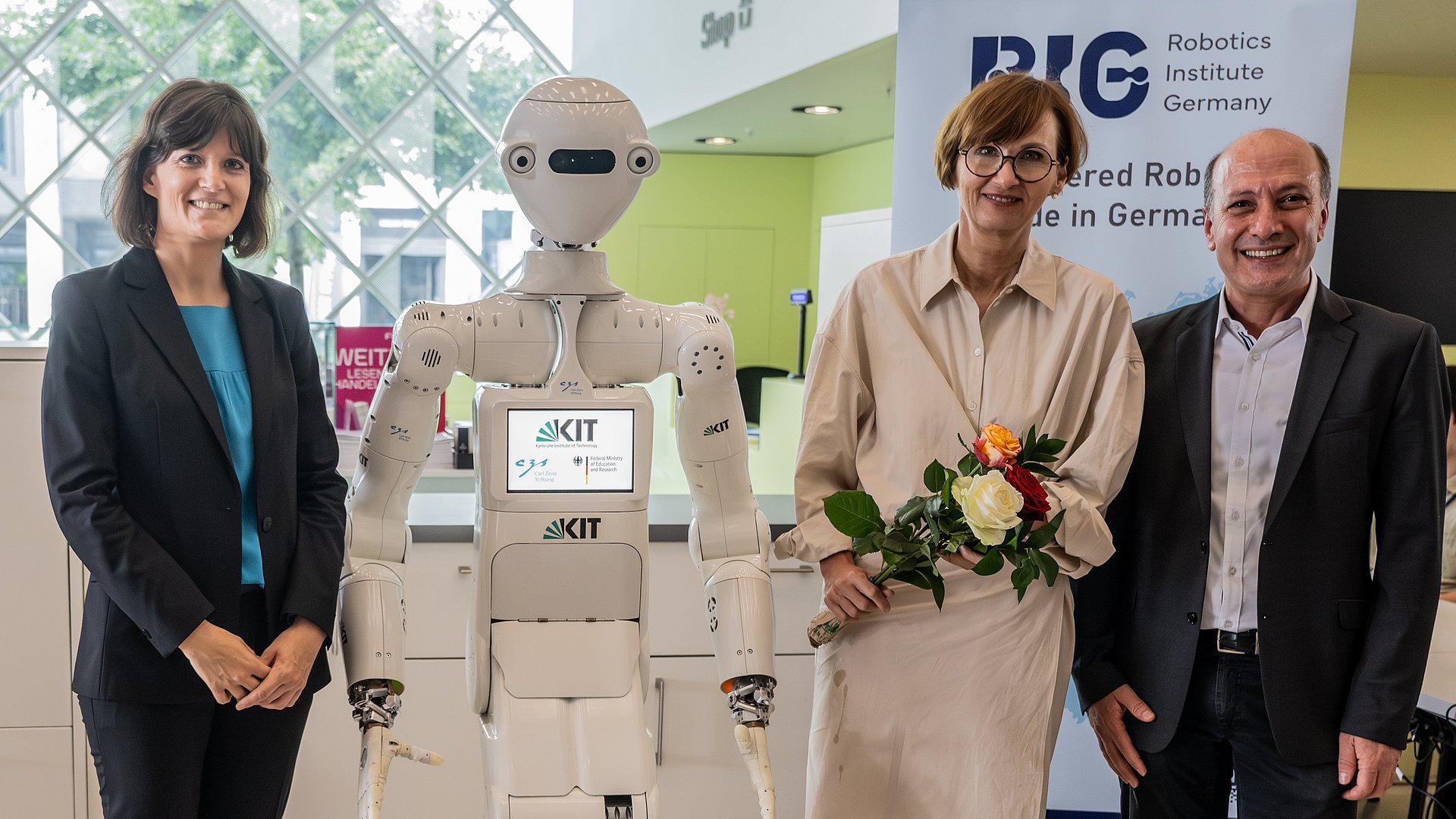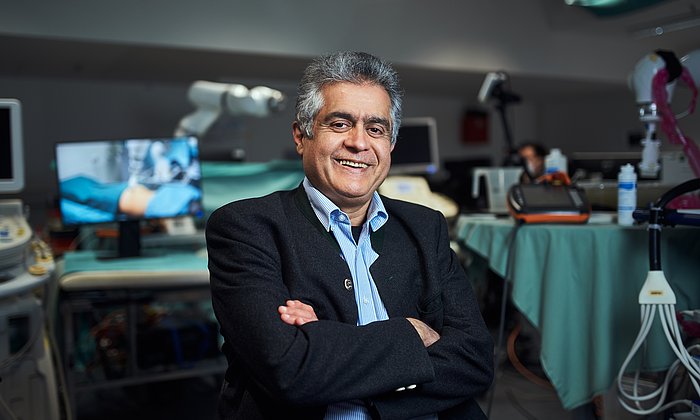Ministry of Education and Research funds top robotics consortium in Germany
Robotics Institute Germany established

"I am delighted that we have succeeded together in establishing a robotics network with such strong partners from universities and non-university institutions for this pioneering AI-based robotics concept," says Prof Angela Schoellig from consortium leader TUM: "The RIG is a historic initiative that comes at exactly the right time. We are responding to current trends in the USA, for example, where many well-known companies are investing heavily in AI-based robotics. We are doing this with our program, which is geared towards cutting-edge research and talent."
Intelligent robots as a "Made in Germany" export success
Intelligent robotics solutions will not only transform the economy, but also reshape our lives. This is because they will influence healthcare, education, mobility solutions and the environmental sector in equal measure. The RIG aims to use robotics to build on innovations in the chemical, pharmaceutical and automotive industries, which have established Germany as an industrialized nation in the past and ensured prosperity and growth for decades. "Germany has the potential to play a pioneering role in embodied AI," explains RIG coordinator Prof Schoellig. "Intelligent robots could become the next big export hit "Made in Germany"."
The initial conditions are favorable: Germany’s roboticists are among the global leaders in AI-based robotics and have made significant contributions to the international robotics landscape. "However, Germany has so far lacked a strategic approach that bundles the existing potential and utilizes synergies to secure Germany's long-term competitiveness and promote excellence and economic growth. We will establish the RIG as a nationally recognized and internationally unique institute that shapes cutting-edge research, education and innovation in AI-based robotics and aligns it with Germany's needs," explains RIG spokesperson Prof. Tamim Asfour from the Karlsruhe Institute of Technology (KIT).
The Who's Who of German robotics united in the RIG
In addition to TUM and KIT, eight other universities from all over Germany are involved: the University of Bonn, the Technical University of Berlin, the Technical University of Darmstadt, the University of Bremen, the University of Stuttgart, RWTH Aachen University, the Technical University of Dresden and the Technical University of Nuremberg. Also participating are the German Aerospace Centre (DLR), the Max Planck Institute for Intelligent Systems, three Fraunhofer Institutes (IPA, IOSB and IML) and the German Research Centre for Artificial Intelligence (DFKI) as well as 19 associated partners. Collaboration is planned with other German and international partners, for example from industry.
Federal Research Minister Bettina Stark-Watzinger said: "Germany is already well positioned in both AI and robotics research. So the time for AI-based robotics is right now. To this end, we are expanding our new Robotics Institute Germany (RIG) and bringing together the best talent. This will create a decentralized network of cutting-edge research locations. In this way, we are creating the conditions to integrate the enormous potential of AI into robotic systems."
TUM President Prof Thomas F. Hofmann said: "Robotics is a key driver of Germany's innovative strength and competitiveness. With the Munich Institute for Robotics and Machine Intelligence (MIRMI), which was established as part of the Excellence Strategy of the German federal and state governments, we are pooling the research excellence of almost 70 scientists in the use of embodied artificial intelligence for the future of health, work, mobility and sustainability. This makes us capable of forming strong alliances. We are now coordinating the establishment of the Robotics Institute Germany with the aim of taking on a leading international role together with the other consortium partners."
Robotics and AI research at TUM has developed strongly thanks to support from the „Hightech Agenda Bavaria“. As part of this program, the Free State of Bavaria invests around 5.5 billion euros in innovative research, for example, at the Munich Institute of Robotics and Machine Intelligence (MIRMI). With over 70 active professors, the MIRMI pools the expertise in robotics and AI at TUM to an exceptionally high degree. This was ultimately one of the arguments in favor of making Munich the location of the RIG.
The five strategic goals of the Robotics Institute Germany
1. Making research globally competitive
The RIG aims to promote cooperation between robotics locations and establish research clusters for key technologies in Germany. It will generate world-class research for AI-based robotics in Germany with a clear focus on innovation. To this end, the RIG is tasked with addressing the specific challenges in Germany and driving progress with goal-oriented research.
2 Sharing infrastructure and resources
The RIG partners will utilize their infrastructure and resources for joint research. This includes physical and virtual laboratories as well as software and research data. Data and software will be shared in a dynamic, open ecosystem.
3. Promoting talent and offering training and education
The focus of the RIG talent program is to find and develop talent. This will include the development of an RIG curriculum for research-oriented teaching of AI-based robotics, a standardized introductory bachelor's course and new English-language master's programs as well as a RIG doctoral program for robotics. Efforts to attract talent will begin in schools, where RIG plans to create robotics and AI courses for upper secondary schools and support talented pupils.
4. Making robotics research comparable through benchmarking and competitions
RIG robotics benchmarks will be created in our own laboratories to allow standardized testing of such skills as object manipulation, navigation in difficult terrain or human-robot interactions. With these benchmarks, the RIG will set new standards for the evaluation of robotic systems in areas such as personal assistance, flexible production and logistics. In addition, competitions such as the Autonomous Racing Challenge, RoboCupHumanoid Soccer or RoboCupRescue for search and rescue robots will play an even greater role in the future and a special RIG challenge will be developed.
5. Simplifying the transfer of research outcomes for industry
To turn research into competitive products, research and industry must cooperate closely. The RIG innovation program aims to identify the technical needs of industry and increase the technology readiness level. The RIG wants to promote the start-up culture and motivate researchers in particular to develop new application fields for robotics. The decisive criteria: the number and size of new start-ups, the number of patents and the amount of direct funding from industry will be reviewed every year.
Further information:
Profile Robotics Institute Germany (RIG):
- Start: 1 July 2024
- Budget: 20 million euros
- Duration: July 1, 2024 to June 30, 2028
- Funding: Federal Ministry of Education and Research (BMBF)
- Consortium leader: Technical University of Munich (TUM)
Full partners:
- TUM, Karlsruhe Institute of Technology (KIT), University of Bonn, Technische Universität Berlin, Technische Universität Darmstadt, University of Bremen, University of Stuttgart, RWTH Aachen, Technische Universität Dresden, Technische Universität Nürnberg, German Aerospace Center (DLR), the Max Planck Institute for Intelligent Systems, Fraunhofer Institute for Manufacturing Engineering and Automation IPA, Fraunhofer Institute of Optronics, System Technologies and Image Exploitation IOSB, Fraunhofer Institute for Material Flow and Logistics IML and the German Research Centre for Artificial Intelligence (DFKI).
Associated partners:
- University of Augsburg, University of Bayreuth, University of Bielefeld, Braunschweig University of Technology, Chemnitz University of Technology, Friedrich-Alexander University Erlangen-Nuremberg, University of Freiburg, University of Hamburg, Leibniz University Hannover, University of Heidelberg, Ilmenau University of Technology, University of Kaiserslautern-Landau, University of Lübeck, Ludwig-Maximilians-Universität München, University of Tübingen, Baiosphere, Cyber Valley GmbH, Hessian Centre for Artificial Intelligence, German Rescue Robotics Centre e.V.
Technical University of Munich
Corporate Communications Center
- Andreas Schmitz
- presse@tum.de
- Teamwebsite
Contacts to this article:
Prof Angela Schoellig (RIG Coordinator)
Chair of Safety, Performance and Reliability of Learning Systems and Munich Institute of Robotics and Machine Intelligence (MIRMI)
Technical University of Munich (TUM)
angela.schoellig@tum.de
Prof Tamim Asfour (RIG spokesperson)
Institute of Anthropomatics and Robotics
Karlsruhe Institute of Technology (KIT)
tamim.asfour@kit.edu


